![]()
![]()
![]()
Use LEFT and RIGHT arrow keys to navigate between flashcards;
Use UP and DOWN arrow keys to flip the card;
H to show hint;
A reads text to speech;
50 Cards in this Set
- Front
- Back
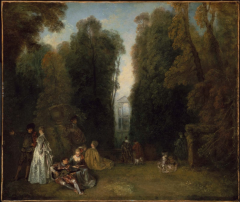
|
La Perspective (View through the trees in the park of Pierre Crozat) 1. 1715 2. Antoine Watteau 3. Rococo (delicate colors and nature) 4. Fete Galante showed aristocratic value of the period |
|
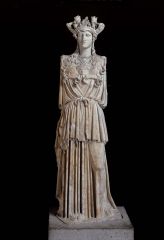
|
Athena Parthenos 1. 2nd or 3rd century 2. Roman replica of Greek original 3. Was worshiped as the god of wisdom 4. "Athena the Virgin" 5. Original in the Parthenon was highly admired, made of gold and ivory |
|

|
The Ecstasy of St. Theresa 1. 1645-1652 Comoro Chapel in Rome 2. Gian Lorenzo Bernini 3. Sculpture, painting, and architecture 4. Super Baroque 5. St. Theresa being pierced in the heart by an angel on a cloud in the sun |
|

|
Book of Kells 1. 760-820 Scotland, Ireland, England 2. An illuminated manuscript Gospel book 3. New testament, four Gospels, and various prefatorytexts 4. Priests/nuns copied bible into it 5. Pages made of animal skin/intestines 6. Geometric shapes that flow |
|

|
Birth of Venus 1. 1482 Florence 2. Sandro Botticelli 3. Linear style that resembled art from the Byzantine era 4. Nudes were Renaissance 5. Rebirth of classical mythology |
|
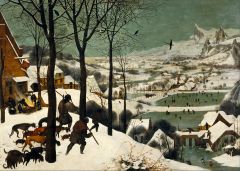
|
Hunters in the Snow 1. 1565 currently in a museum in Vienna 2. Pieter Bruegel 3. Northern Renaissance 4. Hunters returning from an unsuccessful hunt 5. Calm and cool muted colors, depth in background, struggles of life |
|
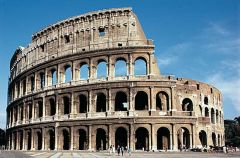
|
Colosseum 1. 70-82 AD Rome 2. Seated 50,000 people 3. Unified all classes of people 4. Doric, Ionic, Corinthian columns |
|
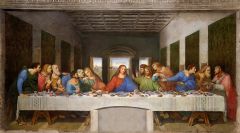
|
The Last Supper 1. 1495 Milan 2. Leonardo Da Vinci "Renaissance Man" 3. Final meal Jesus shared with Apostles before being crucified 4. Stressed intellectual aspects of art and creativity 5. Deep background brings focus to people 6. Geometric and focused at center |
|

|
Oath of Horatii 1. 1784 France 2. Jacques-Louis David 3. Death of Rococo and birth of Neoclassical art 4. Depicts self sacrifice not self indulgence (for the greater good) 5. Revolution approached so art depicted loyalty 6. Contrast with crying lady 7. Focal point at hands |
|
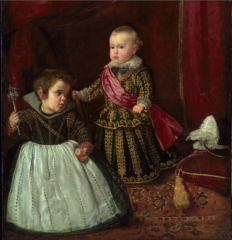
|
Don Baltasar Carlos with a Dwarf 1. 1632 2. Diego Rodrigues de Silva y Velazquez 3. Spanish Baroque 4. Painted for royalty (outfits) 5. Two year old child is frozen like a royal portrait 6. Dwarf holding playthings that represent orb and scepter in childs future as king |
|

|
Statue of David 1. 1430-1432 Florence 2. Donatello 3. Work was classical sculpture (contrapposto stance) 4. Realistic and accurate underlying skeletal structure 5. Pioneered renaissance style sculpture with rounded body |
|
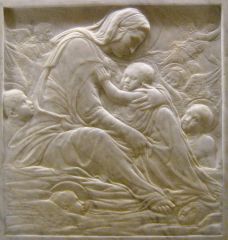
|
Madonna of the Clouds 1. 1425-1435 Italy 2. Donatello 3. Italian Renaissance 4. Madonna sits as if on the ground, to convey the idea of humility, 5. In cloud because she's the Queen of Heaven. 6. A feeling of weighty foreboding is expressed in the Madonna’s somber profile, which seems to look into the Christ Child’s tragic future. |
|

|
Dormition of the Virgin 1. 1350-1360 Bohemia 2. Unknown artist 3. Originally part of an altarpiece King Charles IV 4. Virgin Mary slept for 3 days before going to heaven but they think she's dead |
|

|
Funerary Relief of the Publius Gessius Family 1. 50-20 BC 2. Half-figure portraits of three members of the family of the Gessi 3. One of five categories of Roman sculpture 4. sarcophagus decorated with sculpture depicting allegory, mythology, or everyday life. |
|

|
Noli Me Tangere 1. 1305 Italy 2. Giotto 3. Italy (technical skill) remained in contact with Byzantine (softer more lifelike forms) 4. Resurrection of Christ 5. Influential religious painting |
|

|
The Third of May 1808 1. 1814-1815 Madrid 2. Francisco Goya 3. Protested brutality of war by giving faces to victims and none to shooters 4. Use of light on man and not on church questioning humanity 5. Center man in crucification pose 6. Different because war wasn't depicted as glorious by him |
|

|
Hagia Sophia 1. 532-37 Istanbul, Turkey 2. Justinian ordered its construction 3. Holy Wisdom 4. Established as a church became a mosque 5. Inside is very extravagant and the use of light makes it feel like the house of God. |
|
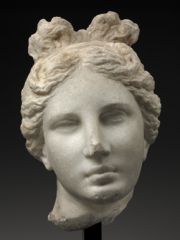
|
Head of Aphrodite (The Bartlett Head) 1. 330-300 BC Ancient Greece 2. Late classical or early Hellenistic sculpture 3. Greek idealism 4. Soft, round face shows kindness and compassion 5. Aphrodite is the goddess of love 6. She lost her body :( |
|

|
Mars and Venus 1. 1630 2. Nicolas Poussin 3. French Baroque 4. restrained and idealizing style, inspired by the art of classical antiquity and the Renaissance 5. Venus beats Mars allegory triumph of love over war 6. Beautiful landscape and soft warm colors |
|

|
Slave Ship (Slavers Throwing Overboard the Dead and Dying, Typhoon Coming On) 1. 1840 2. Joseph Mallord Turner 3. Romanticism 4. Displayed his admiration for human and natural violence 5. True story of a captain in 1781 who threw slaves overboard for insurance money |
|
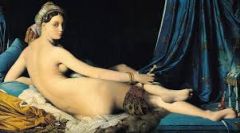
|
La Grande Odalisque 1. 1814 France 2. Jean Auguste Dominique Ingres 3. Neoclassicism 4. Smooth brush strokes, emotion, color, elegance, and technical skill 5. More mannerist than renaissance |
|

|
King Menkaure and Queen 1. 2490-2472 BC Egypt 2. Representative of idealized concept if monarchy 3. Precise carvings that withstood time 4. Size of figures suggests equality 5. Shoeless on holy land 6. Not finished |
|
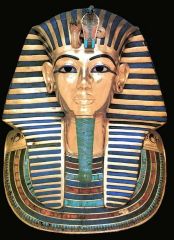
|
King Tut's Mask 1. Egypt 1352 BC 2. Died at 19 and was unimportant 3. B/c tomb was discovered in almost perfect condition 4. GOLD |
|

|
The Tribute Money 1. 1427 Florence 2. Masaccio 3. Used perspective, light source, and 3D people 4. Great example of illusion of depth (new Renaissance style) 5. Use of Vanishing point to ^ |
|

|
Augustus 1. 1st or 2nd century Ancient Greece 2. Carved out of Lychnites marble from the Greek island of Paros 3. Curly locks of hair, no wrinkles, softened bone structure 4. Idealized image influenced by Greek statues of athletes and athletic gods. |
|

|
The Creation of Adam 1. 1508-1512 Sistine Chapel 2. Michelangelo 3. Creation of man book of Genesis 4. Incredible detail focused on anatomy 5. God created man in his own image 6. Spark of life from God yet to reach Adam |
|

|
Pieta "Pity" 1. 1498-1500 Vatican 2. Michelangelo 3. Jesus on Mary's lap after crucifixion 4. Pyramid structure copied from Da Vinci 5. Balance of Renaissance ideals of classical beauty and naturalism 6. Out of proportion and Mary is too young |
|

|
Queen Nefertiti 1. Egypt approx. 1360 BC 2. Husband Pharaoh Akhenaton 3. Icon of female beauty 4. Sculpture is a natural representation of the Queen. |
|
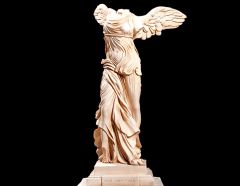
|
Nike of Samothrace (The Winged Victory) 1. 190 BC 2. Pythokritos of Rhodes maybe? 3. Mastery of form and movement 4. Loss of head enhances sense of supernatural 5. Honored a sea battle Goddess was on the prow of a ship 6. Drapery appears to be blowing in the wind |
|

|
The Pantheon 1. 118-125 Rome 2. Commissioned during reign of Augustus 3. Large granite Corinthian columns 4. Concrete coffered dome has oculus at the top 5. The world's largest unreinforced concrete dome |
|

|
The Parthenon 1. 448-432 BC Acropolis, Athens 2. Dedicated to Athena 3. Most important surviving classical greek building 4. Ionic and Doric architectural features 5. 8x17 columns 6. Housed Athena Parthenos |
|
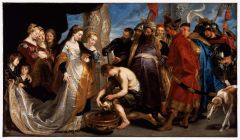
|
Head of Cyrus Brought to Queen Tomyris 1. 1622-1623 2. Peter Paul Rubens 3. Flemish Baroque 4. Queen Tomyris defeated Persian King Cyrus 5. Revenge for his part in her sons death 6. Women power! |
|

|
Pyramids of Giza 1. Approx. 2560-2540 BC 2. Great pyramids (3), Sphinx, and cemetaries 3. Protect pharaoh's Ka (spirit) during the afterlife |
|

|
School of Athens 1. 1510-1511 Vatican 2. Raphael 3. Embodies high Renaissance 4. Fusion of Christian and Pagan elements 5. Representing Philosophy 6. Perfect embodiment of the classical spirit of the Renaissance 7. One in four frescos that represent branches of knowledge |
|
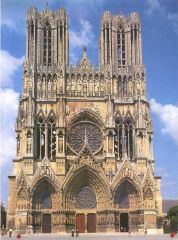
|
Reims Cathedral 1. Started in 1211 after last church fire 2. Gothic: Verytall, airy, symmetricaland elaborate 2. Jamb figures Little elongated people detailed each with unique story) 1225-90 3. Stained glass windows 4. Builtby guilds (groups of workers) so many projects were communal and artists arenot know |
|
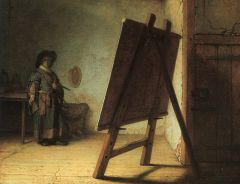
|
Artist in His Studio 1. 1628 2. Rembrandt 3. Daunting moments of conception and decision necessary in creating art 4. Emphasis on thought instead of action 5. Painting is the subject and the artist is dwarfed by it |
|

|
Saint Luke Drawing the Virgin 1. 1435-1440 2. Rogier Van Der Weyden 3. Northern Renaissance 4. According to tradition St. Luke created first portrait of Jesus and Virgin Mary 5. Enclosed garden refers to Virgin's purity 6. Adam and Eve refer to their roles in redeeming mankind's sin |
|

|
The Dead Christ With Angels 1. 1524-1527 2. Rosso Fiorentino 3. Italian Mannerism (unusual color combos, crowded space, elongated twisted figures) 4. Shows the moment of Christ's resurrection |
|

|
Marie Arrives ar Marseilles 1. 1622-1625 France 2. Rubens 3. Part of a 21 large scale oil painting set celebrating the life of Queen Mariede'Medici 4. Baroque 5. Triumphant and extravagant |
|

|
Seated Sekmet 1. 1390-1352 BC Egypt 2. Originally the warrior goddess as well as goddess of healing 3. Lioness (fiercest hunter) 4. Protected pharaohs 5. Solar deity (maybe daughter of RA) |
|

|
Stonehenge 1. England approx. 2,000 BC 2. Believed to be created by an ancient race of giants or conjured by a magician. 3. Accurate astronomical calendar |
|

|
Two Handled Jar with Herakles Driving a Bull to Sacrifice 1. 525-520 BC Ancient Greece 2. The Andokides Painter and Lysippides Painter 3. Black figure pottery |
|
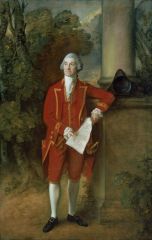
|
John Eld of Seighford Hall, Stafford 1. 1795 2. Thomas Gainsborough 3. English Baroque known for handsome imposing portraits 4. Liberal philanthropist helped found an infirmary 5. Powerful man holding print of hospital |
|

|
The Last Supper 1. 1594 Vienna 2. Tintoretto 3. Mannerist traits: crowded, off balance (diagonal table), light coming from Christ's head (emotion). |
|

|
Arnolfini Wedding 1. 1434 London 2. Van Eyke 3. Realism 4. Symbolizes the sanctity of marriage: Dog (fidelity) and shoes (holy ground) |
|

|
Las Meninas 1. 1656 Madrid 2. Velazquez 3. Royal portrait of 5 year old princess Margarita 4. Geometric and centered at the bottom of the page 5. Depth and light bring out people 6. Visual realism |
|

|
Venus of Willendorf 1. Willendorf Austria 25,000-20,000 BC 2. One of the earliest known human figurines 3. Female parts emphasized 4. Fertility statue |
|

|
The Kitchenmaid 1. 1658 Amsterdam 2. Vermeer 3. Used bright and intense colors because he loved light 4. Lots of texture with the paint |
|
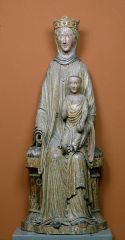
|
Virgin and Child 1. 1210-1225 France 2. Queen of Heaven with Jesus in her lap 4. Elongated proportions and small head exterior of French Gothic Cathedrals |
|
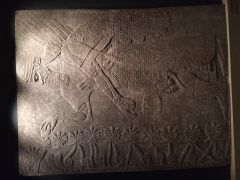
|
Winged Protective Deity 1. 883-859 BC Assyrian 2. Protect people from unseen terrors/keep king from harm 3. Were painted on palace walls 4. Writing in the middle is a record of the king's achievements and conquests |

